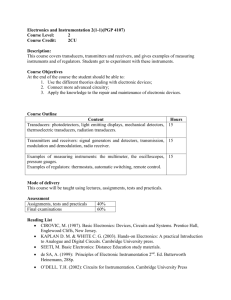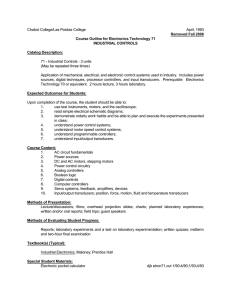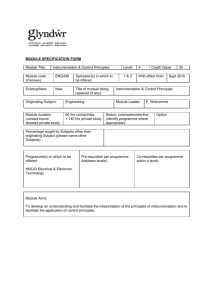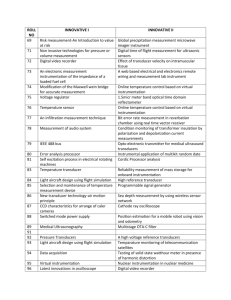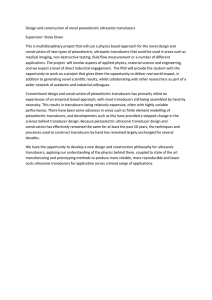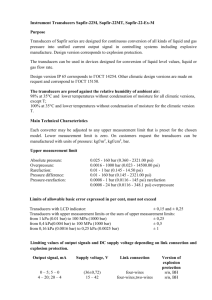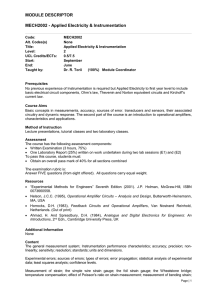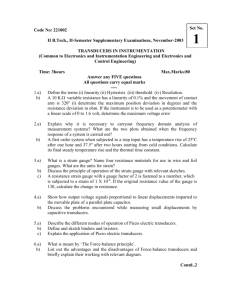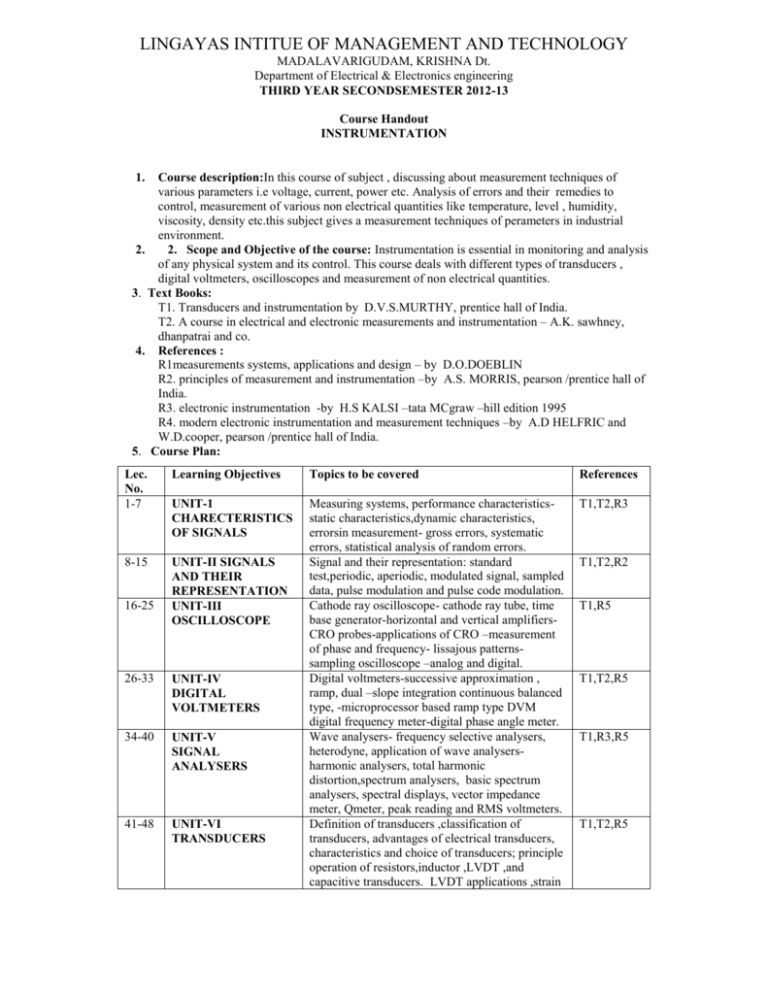
LINGAYAS INTITUE OF MANAGEMENT AND TECHNOLOGY
MADALAVARIGUDAM, KRISHNA Dt.
Department of Electrical & Electronics engineering
THIRD YEAR SECONDSEMESTER 2012-13
Course Handout
INSTRUMENTATION
1.
Course description:In this course of subject , discussing about measurement techniques of
various parameters i.e voltage, current, power etc. Analysis of errors and their remedies to
control, measurement of various non electrical quantities like temperature, level , humidity,
viscosity, density etc.this subject gives a measurement techniques of perameters in industrial
environment.
2.
2. Scope and Objective of the course: Instrumentation is essential in monitoring and analysis
of any physical system and its control. This course deals with different types of transducers ,
digital voltmeters, oscilloscopes and measurement of non electrical quantities.
3. Text Books:
T1. Transducers and instrumentation by D.V.S.MURTHY, prentice hall of India.
T2. A course in electrical and electronic measurements and instrumentation – A.K. sawhney,
dhanpatrai and co.
4. References :
R1measurements systems, applications and design – by D.O.DOEBLIN
R2. principles of measurement and instrumentation –by A.S. MORRIS, pearson /prentice hall of
India.
R3. electronic instrumentation -by H.S KALSI –tata MCgraw –hill edition 1995
R4. modern electronic instrumentation and measurement techniques –by A.D HELFRIC and
W.D.cooper, pearson /prentice hall of India.
5. Course Plan:
Lec.
No.
1-7
Learning Objectives
Topics to be covered
References
UNIT-1
CHARECTERISTICS
OF SIGNALS
T1,T2,R3
8-15
UNIT-II SIGNALS
AND THEIR
REPRESENTATION
UNIT-III
OSCILLOSCOPE
Measuring systems, performance characteristicsstatic characteristics,dynamic characteristics,
errorsin measurement- gross errors, systematic
errors, statistical analysis of random errors.
Signal and their representation: standard
test,periodic, aperiodic, modulated signal, sampled
data, pulse modulation and pulse code modulation.
Cathode ray oscilloscope- cathode ray tube, time
base generator-horizontal and vertical amplifiersCRO probes-applications of CRO –measurement
of phase and frequency- lissajous patternssampling oscilloscope –analog and digital.
Digital voltmeters-successive approximation ,
ramp, dual –slope integration continuous balanced
type, -microprocessor based ramp type DVM
digital frequency meter-digital phase angle meter.
Wave analysers- frequency selective analysers,
heterodyne, application of wave analysersharmonic analysers, total harmonic
distortion,spectrum analysers, basic spectrum
analysers, spectral displays, vector impedance
meter, Qmeter, peak reading and RMS voltmeters.
Definition of transducers ,classification of
transducers, advantages of electrical transducers,
characteristics and choice of transducers; principle
operation of resistors,inductor ,LVDT ,and
capacitive transducers. LVDT applications ,strain
16-25
26-33
UNIT-IV
DIGITAL
VOLTMETERS
34-40
UNIT-V
SIGNAL
ANALYSERS
41-48
UNIT-VI
TRANSDUCERS
T1,T2,R2
T1,R5
T1,T2,R5
T1,R3,R5
T1,T2,R5
49-53
54-60
UNIT-VII
MEASUREMENT OF
NON ELECTRICAL
QUANTITIES -I
UNIT-VIII
MEASUREMENT OF
NON ELECTRICAL
QUANTITIES -II
gauge and its principle of operation, gauge factor,
thermisters, thermocouples, synchros, piezo
electric transducers, photovoltaic, photo
conductive cells, photo diodes.
Measurement of strain, gauge sensitivity,
displacement, velocity, angular velocity,
acceleration, force, torque.
Measurement of temperature, pressure,
vacuum,flow,liduid level.
T1,R5
T2,R3
6. Assignments: Comprises of Reading and/or Home assignments. Details will be announced in the class
from time to time and also will be uploaded in college website.
7. Evaluation scheme: Consists of a series of Closed book and Open book tests after completion of every
Unit in addition to Descriptive and Online quiz exams as prescribed by the JNTUK.
8. Notices: Concerning the course will be displayed on Department Notice Board.
INSTRUCTOR-IN-CHARGE

